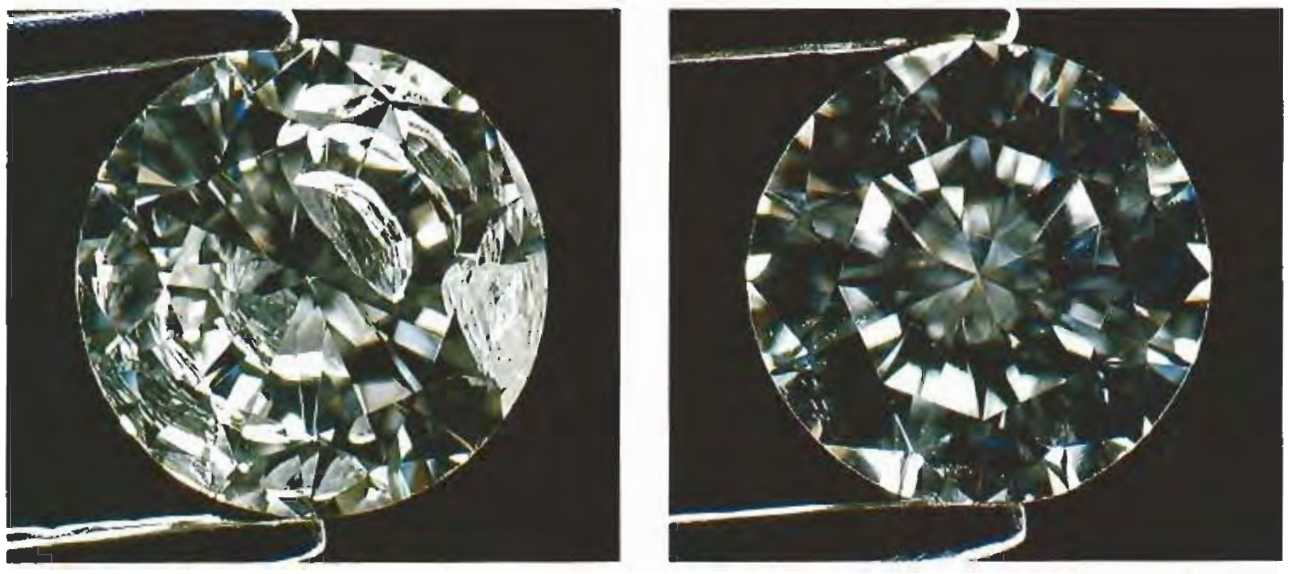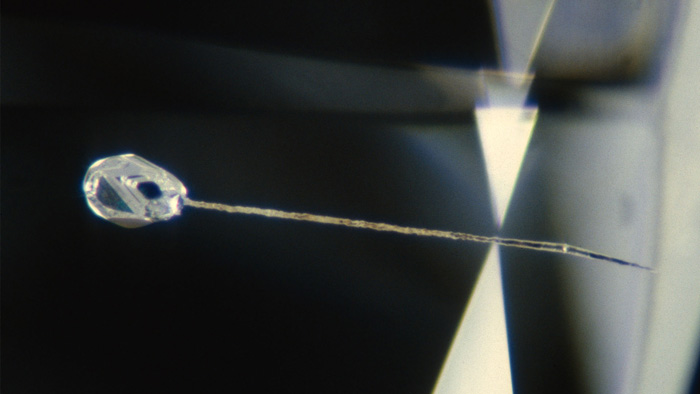My website is reader-supported. Buying through links on my site may result in me earning a CUSTOMER REFERRAL FEE at no extra cost to you.
Check out the latest deals at our top diamond vendor choice: James Allen
The Pros And Cons of a Clarity Enhanced Diamond

Clarity enhanced diamond example (Source: GIA)
When we think of the perfect diamond, we envision brilliant stones with little to no inclusions. Unfortunately, not all natural diamonds are spotless.
Most diamonds carry one or more flaws, such as inclusions or feathers. Diamonds with severe inclusions visible to the naked eye receive low clarity grades and are more difficult to sell than an eye-clean diamond.
Thus, to enhance a natural diamond’s clarity, some jewelers treat their diamonds to make them more attractive for customers.
While such treatment has obvious upsides, such as better clarity and usually a lower price, there are also some serious downsides. Purchasing a treated diamond might not be the best choice when looking for an engagement ring. In this blog post, we’ll cover why that is and what you can do instead of purchasing a clarity-enhanced diamond.
Treatment Process: Laser drilled diamonds vs fracture filled diamonds
There are two different methods that industry experts use for clarity enhancement: Fracture filling and laser drilling.
Fracture filling
Jewelers choose the fracture filling treatment when a diamond shows a fracture or so-called “feather” inclusion. Although jewelers can remove surface-reaching feathers through polishing, some prefer fracture filling as it does not lead to significant carat weight loss.
During this process, a transparent crystalline substance is injected into surface fractures (scratches and cracks) to make them less visible after the filler is solidified.
Below you can see an example of a fracture-filled diamond:

Source: Clarity Enhancements (GIA)
The above picture shows a diamond with a feather-like inclusion, which is hardly visible after the fracture has been filled.
The artificial filler, which closely matches a diamonds’ refractive index, is transparent and difficult to spot with the naked eye, yet it is not invisible. This is especially true when a trained gemologist looks at the loose diamond. They can quickly tell apart a fracture-filled diamond from an untreated diamond.
Laser drilling
On the other hand, laser drilling is a technique used to remove inclusions such as black spots or foreign crystals embedded within a diamond’s crystalline structure. During this process, a laser beam drills a thin channel from the surface to the inclusion of the diamond. Through the channel, acidic chemicals (typically hydrofluoric acid (HF) and sulphuric acid (H2So4)) are forced into the opening to dissolve and bleach out the inclusions.
The passway is either left as it is (sometimes visible with the naked eye =) or filled with a diamond-like substance.
Below you can see an example of a. laser drilled diamond:

Source: Clarity Enhancements (GIA)
In the above picture, a laser has drilled away an inclusion in the diamond.
Just like with a fracture filled diamond, a jeweler can easily see whether the diamond has been treated or not.
The pros and cons of clarity enhanced diamonds
Clarity enhanced diamonds have several pros and cons. However, as you will see in the sections below, the upsides of clarity enhanced diamonds are directly related to their downsides.
Lower price point of Clarity Enhanced Diamonds
Clarity-enhanced diamonds are cheaper than non-enhanced diamonds. A clarity-enhanced diamond can discount a gem up to 50% or more than the higher-priced natural diamond.
For instance, if you consider purchasing a 1.5-carat diamond with a G color grade and a Si2 clarity grade, you would p $10.5k for a natural diamond and about $4.8k for a treated diamond.
However, diamonds are cheap for a reason. That’s because these clarity-enhanced diamonds usually start as low-tier diamonds in the low I2-I3 clarity ranges. Some unethical jewelers misrepresent these low-quality diamonds and make incorrect comparisons to properly graded diamonds.
Jewelers who sell these clarity-enhanced diamonds often use prices for GIA graded VS or VVS diamonds as a benchmark. These GIA diamonds are going to cost more!
If price is something you care about, consider lab-created diamonds. They offer a higher carat weight and higher quality for any given budget.
Vendors often offer a lifetime of free repair
Because of the non-permanent nature of fracture-filled diamonds, most companies selling such stones offer lifetime repairs for their products. However, the second filling will never be as good as the first one because it is impossible to reverse the process once a diamond is filled with resin.
CON: NO GIA AND AGS REPORTS
 On the downside, the Gemological Institute of America (GIA), the American Gem Society (AGS), and the International Gemological Institute (IGI) do not issue grading reports for diamonds that have been treated.
On the downside, the Gemological Institute of America (GIA), the American Gem Society (AGS), and the International Gemological Institute (IGI) do not issue grading reports for diamonds that have been treated.
That means you have to relinquish safety, as I only recommend buying diamonds from vendors who offer diamond reports issued by the GIA or AGS.
Con: LESS DURABILITY
While a diamond is resistant to high temperatures or any chemicals, this is not true for treated diamonds. High temperatures or acidic substances may alter the diamond-like substance and break the diamond in the worst case. Hence, enhanced diamonds are less durable than natural diamonds.
Con: TREATMENT MIGHT BE VISIBLE WITH THE NAKED EYE
While the treatment enhances the diamond’s clarity, the trained eye can very well detect treated areas on the diamond.
Fracture filling can impact the diamond’s appearance and brilliance. The diamond might appear flawless from the top, but when viewed from other angles, the filling can disrupt the passage of light through the facets. Fracture-filled diamonds can become cloudy or hazy over time. Sometimes air bubbles can even get trapped in a filling.
Additionally, treated diamonds require extra care, as the glass-like filling substance cannot be exposed to chemicals or even simple ultrasonic cleaning routines.
HOW TO TELL A REAL DIAMOND/GEM FROM A FAKE/CLARITY ENHANCED ONE?
Depending on which treatment the jeweler chooses, it can be easy or difficult to spot the treated area. Sometimes, it is possible to see the lasered pathway.
Some diamonds also exhibit a so-called “flash effect.” The flash effect appears as a line of vivid color (usually blue, purple, or red) or at the location of the enhancement.
Furthermore, if you purchase a treated diamond, you will not receive a professional GIA or AGS report. That means you can never be 100% sure whether your diamond is real or fake.
You also won’t know what your diamond’s real value is. This becomes especially problematic if you intend to sell the diamond later on.
ARE CLARITY ENHANCED DIAMONDS SUITABLE FOR AN ENGAGEMENT RING?
If you have a budget for your diamond purchase, a lower price for a larger Clarity Enhanced Diamond means that you could afford a larger, brighter diamond and stay within your price range. However, the downsides to clarity-enhanced stones are significant, making enhanced diamonds often poor for engagement ring settings.
I always recommend buying diamonds from vendors who provide GIA and AGS reports. These are the reports you can trust. Additionally, you might want to check out lab-grown diamonds.
WHERE TO BUY CLARITY ENHANCED DIAMONDS?
The truth is that reputable vendors do not sell clarity-enhanced diamonds due to the cons named above. They only sell natural, untreated diamonds. And each diamond comes with a professional grading report (something you should always look out for!).
You can already save a lot of money when buying a diamond online anyway, as they have much lower operational costs and can sell you a diamond for a discounted price. But don’t take my word for it; check it out yourself : )
For example, James Allen is the leader in online diamond sales. Their imaging technology is the same as inspecting a diamond with a jeweler’s loupe. They have the largest exclusive loose diamond inventory online and fantastic prices. They also have the nicest collection of lab-created diamonds online.
Now save 25% off engagement ring settings AND 3% off Earth Diamonds during James Allen HUGE limited-time sale!
Conclusion
Advanced technology nowadays has enabled the jewelry industry to improve the visual appearance of lower-grade diamonds by laser drilling or fracture filling.
If you are looking for larger stones at an affordable price, this may be the perfect fit for you as clarity-enhanced diamonds are priced lower than other natural diamonds.
However, several drawbacks, such as no grading reports and low durability, make them unpopular for engagement rings.
If you still want to save money, consider buying a diamond online. Due to the lack of overhead costs, online jewelers can offer their diamonds at lower prices. Lab-created diamonds are specifically budget-friendly.
Diamond Quiz
Can you tell the difference?
One of the two diamonds below has a clarity grade of VVS1, the other one of VS1. Can you tell which one has the lower clarity grade and costs $1000 less?






